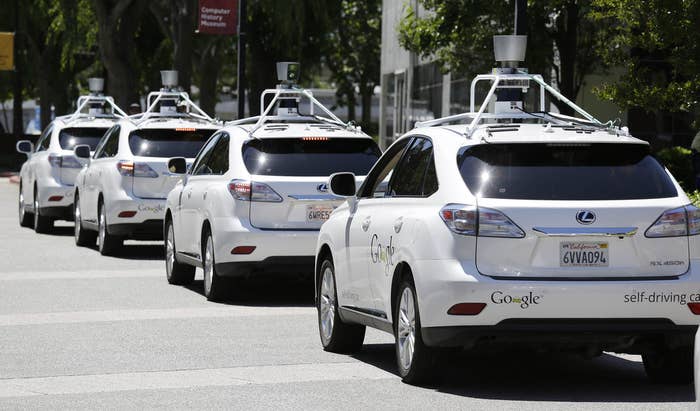
The United States Department of Transportation released a new study today, a 30-year framework that looks at the future of road, rail, ship, and air transportation. It's called "Beyond Traffic," and it's pretty grim.
The report paints a picture of a gridlocked future, with bridges that won't hold up under the weight of the vehicles passing over them, airport runways submerged by rising seas, ports unable to keep up with their international counterparts or move goods in a timely manner, commuter trains that don't stop to pick up passengers, and roadways clogged with vehicles. Basically, it sounds like a nationwide version of San Francisco.
Yet while "Beyond Traffic" stops short of making concrete recommendations, several themes emerge, and many of them revolve around technology — especially the use of robotics, GPS, mobile devices, and advanced vehicle-to-vehicle communication systems to reduce congestion in our airspaces, on our roadways, and at our ports. It very much leans on the technology industry to fix the nation's transportation woes. Perhaps unsurprisingly then, the report is being announced not in Washington, D.C., but at a fireside chat at Google today, where U.S. Department of Transportation Secretary Anthony Foxx will appear with Google's Executive Chairman Eric Schmidt.
"Technology is one of the major factors that we focus on in this report, so we thought coming out to the heartbeat of the technology community in this country was an important signal," Foxx told BuzzFeed News. "We're at a critical point in American transportation. We have these many legacy systems, like the aviation system, that we basically started and that world has now replicated. We built infrastructure systems to support each of these innovations. But we're mired in today and we need to look forward."
One of the major recurring themes that emerges in the report is the move to an automated transportation system, where networked vehicles dominate the roads, airways, ports, and rails, easing congestion while simultaneously putting more vehicles into the system. However, it also notes that without a comprehensive regulatory framework, achieving an automated future will be impossible. Foxx noted that while the government has to ensure the safety of things that go into the marketplace, it also has to try to get out of the way of some of these systems.
"With the rate of change that's happening in technology, we do also need to ask whether our processes, procedures, programs are keeping up," he noted.
Foxx also largely dismissed concerns with autonomous vehicles, noting that privacy and safety concerns would have to be ironed out, but that he expected those things to happen.
"What's interesting is that if you look back 100 years or so, there were probably similar fears about the airplane, there were probably similar fears about the automobile," Foxx said. "Again, I think one of the great opportunities a report like this offers is giving us enough of a window into the future that it sparks some of the dialog that we need to have now. Maybe some of the fear dissipates, maybe we develop mechanisms to deal with some of the specific concerns people have — concerns like privacy and security — but you never can get there if you don't start the conversation."
He was also largely bullish on the effect on-demand services like Uber will have on society and our networks, as they can affect everything from cargo to passengers. "We're starting to see it now," he said. "Trucks that are not fully developing ways to use technology to fill the truck up with other stuff, and to drop it off where it's needed. It's fascinating what delivery companies are coming up with now."
The report also stokes fears of a transportation system that leaves many behind — it has an anecdote of a woman living 30 years in the future and unable to ride on an overcrowded passenger train, for example. Foxx, however, was mostly optimistic about transit agencies' abilities to overcome these problems without creating a two-tiered system where only those who can afford an Uber get where they need to go on time.
"You're going to see public transit agencies behaving more like Uber," he said. "With the advent of technology that will let you pay for things using an app, I think you're going to see public transit agencies using apps to collect fares. That will come as a huge convenience for consumers, and to transit agencies, that spend a lot of time taking that money, collecting it, counting it, and moving it over to a bank. I think it's really going to cut down on some of the administration costs."
"The other thing that may be looked at is who is to say there aren't joint ventures with some of these on-demand services to provide transit services," he said. "It may seem like a wild idea today, but you don't know."
The report is out today, and available for download. Secretary Foxx will appear at Google at 3 p.m. PT, and plans to arrive in an autonomous vehicle.

